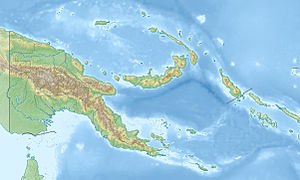Carteret Islands
| Carteret Islands (Kilinailau) | ||
|---|---|---|
| NASA image of the Carteret Islands | ||
| Waters | Pacific Ocean | |
| Geographical location | 4 ° 45 ′ S , 155 ° 24 ′ E | |
|
|
||
| Number of islands | 7th | |
| Main island | Han Island | |
| length | 25.2 km | |
| width | 16.2 km | |
| Land area | 60 ha | |
| total area | 295 km² | |
| Residents | 2600 (2006) | |
| Map of the atoll | ||
The Carteret Islands (also called Kilinailau or Tulun Islands ) belong to Papua New Guinea and are located 86 km northeast of Bougainville in the Pacific . Administratively, they belong to the Atolls Local Level Government of the North Bougainville District in the autonomous region of Bougainville .
The atoll consists of seven low islands, a maximum of 1.5 m above sea level, and stretches in a horseshoe shape about 25 km in a north-south direction; the total land area is 60 hectares . In 2006, 2600 people lived on the islands.
The islands were named after the British navigator and explorer Philipp Carteret , who discovered them in 1767 on his journey with the Sloop Swallow .
Han is the largest island and is located with the other smaller islands on the edge of the reef that surrounds the lagoon . On the west side (lagoon side) of Han lies the atoll capital Weteili . There are still palm trees on Han, but they will soon die off due to the flooding with salt water.
Islands
The islands in clockwise order starting in the north:
- Yecola (Iesala Island, Yesila, Lesala)
- Irinalan (Iolasa Island, Iolassa, Losola)
- Yoven (Huene Island) (divided into two islands by sea level rise since the 1980s)
- Yeharnu (Han Island)
- Piul Island
- Jangain Island (Lagain)
"Sinking Islands"
Since November 2005 it has been reported worldwide that the Carteret Islands will become uninhabitable in the foreseeable future, it was estimated that they would be completely flooded in 2015. The islanders have been fighting the rising ocean for more than 20 years, building dykes and planting mangroves , but storms and floods have washed away their houses, destroyed the vegetable gardens and spoiled the freshwater sources. Huene has already been cut in two by the rise in sea level. Since 2007 people have been talking about resettlement. The self-help organization Tulele Peisa, founded by the island's residents, has started to settle individual residents on a site on Bougainville provided by the Catholic Church . State resettlement measures promised several times have not yet been implemented.
discussion
The islands flooding could be caused by the destruction of the reefs surrounding the Carteret Islands by dynamite fishing , suggested Fred Terry, director of the Bougainville United Nations Development Project . "During the Bougainville Civil War , people fled the conflict in the Carteret Islands," said Terry. “The islanders had to feed all of these additional eaters and needed more fish. They have destroyed the reef several times in the past. ”A German group of journalists and filmmakers visited the islands in 2008. They consider this reason to be unbelievable. The residents certainly don't fish with dynamite. Besides the outrigger canoes, there are only two motor boats. One for the transport, one belonging to the priest John Bosco Kenzie. Paul Tobasi, the chief of the district of the Papua New Guinea province of Bougainville, denies that the reefs were destroyed by dynamite. Tobasi, regional environmental groups and many NGOs are certain that global warming is causing the islands to flood.
Plate tectonics is seen as another possible cause . The islands are located in one of the most complex tectonic areas in the world. Here the Pacific Plate , the Australian Plate and the South Bismarck Plate collide in a subduction zone along the Neupommern-Bougainville Trench , parts of the oceanic plate are pushed down.
Web links
- Carteret Now - German-language homepage with reports and references
- Carteret Islands by Pip Starr - Video report from the Carteret Islands
- Tectonic plates in region - University of North Dakota - Plate Tectonics (English)
- Pacific Atlantis: first climate change refugees The Guardian (November 25, 2005)
- Photographs taken on Tulun in 1960 - Photos from the Carteret Islands, 1960, National Library of Australia
- Kilinailau Islands ( Memento from December 23, 2010 in the Internet Archive ) The Atoll on oceandots.com (English)
- Shrinking islands CNN video about the situation in the Carteret Islands (January 2007)
- Carteret Islands incl. Video material Spiegel online
Individual evidence
- ^ Richard Lloyd Parry (December 21, 2006). The last tide could come at any time. Then these islands at the end of the Earth will simply vanish The Times , accessed January 23, 2007
- ↑ [1]
- ↑ Background Information on the Carteret Islands (with name variants of the individual islands)
- ^ Background Information on the Carteret Islands
- ^ Anonymous (September 29, 2006). Carterets to be Evacuated due to Rising Sea Level Climate Indymedia , accessed January 23, 2007
- ↑ June 2, 2011 Radio Australia , accessed November 23, 2011
- ↑ (November 10, 2011) 40 atolls families to move to Buka ( Memento of the original from April 5, 2012 in the Internet Archive ) Info: The archive link was inserted automatically and has not yet been checked. Please check the original and archive link according to the instructions and then remove this notice. Post Courier , accessed November 23, 2011
- ^ Greg Roberts (March 30, 2002) Islanders face rising seas with nowhere to go. The Sydney Morning Herald , accessed January 23, 2007



